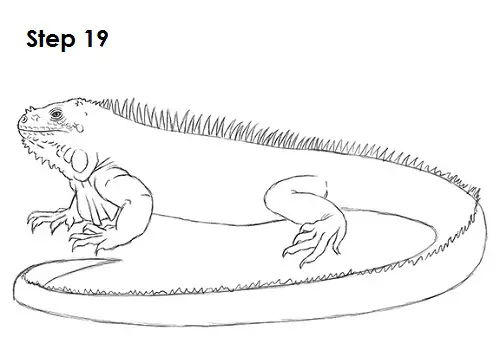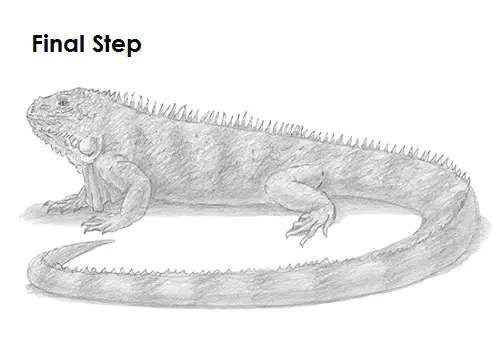Page 4 of 4

Step 15: Use the remaining lines as guides to draw the rest of the iguana's body. Draw a few lines for detail over the arm and add the piece of loose skin under the head called the dewlap. Draw a series of vertical lines to indicate the waves along the skin. This skin helps regulate their temperature.

Step 16: Draw the visible toes of the front leg on the other side by using the small line as a guide.

Step 17: Use the long, curved line as a guide to draw the iguana's tail. Follow the path of the guide as you lightly sketch the shape of the tail. The tail should be thick near the body at the base and gradually get thinner until it comes to a point at the end. When you get the structure of the tail right, go ahead and darken the lines.

Step 18: Draw a series of small triangle-like shapes lining the top of the iguana's body and tail for the defensive spines. Some iguanas have bigger and longer spines than others, so draw yours whatever size you'd like. Don't worry about the spines being perfect. Some can be bent or folded. This gives the drawing a more organic look. Adding all the spines can be a bit time-consuming, so be patient and take breaks. Notice how the row of spines cuts across the shape and continues to the top of the iguana's tail.

Step 19 (optional): For a cleaner look, erase as much as you can of the initial guide lines. Don't worry about erasing all of the guides. It's okay to leave some behind. Re-draw any final sketch lines that you may have accidentally erased.

Final Step (optional): Add some shading to your iguana drawing to give it more dimension and volume. Pick the direction of the light source when shading so that the shadows are consistent with it. Vary the pressure on your pencil to get different degrees of tonal value. The shading doesn't have to be too smooth. Iguanas are scaly, so it's okay to have a rough, bumpy texture. Shading takes time, so be patient as you add value. Split up the pieces of the body so you won't be overwhelmed. Shading individual sections splits up the process. You can then focus on, say, getting the front leg right, then the hind leg and so on.
Add a cast shadow underneath. This helps ground the iguana so it doesn't appear to be floating. The iguana is close to the ground, so the shadow shouldn't be too big. It should be darker close to the body and lighter farther away.
You can add more value throughout your iguana drawing for extra detail. Add the value using a single tone throughout the entire body. Don't add the value smoothly. You want to create a rough, scaly texture. You're basically scribbling randomly all over the body rather than adding smooth, even shading. Some iguanas have a striped pattern on their body. To add this, use a darker value and section off some rectangular shapes on the body. It's always a good idea to use reference for a more accurate drawing. If you have an iguana, try to duplicate its pattern on your drawing. Don't forget to pause the video after each step to draw at your own pace.
Thanks for watching! Subscribe to the
How2DrawAnimals YouTube Channel for a new tutorial every Tuesday.
To learn how to draw popular cartoon characters, visit
EasyDrawingTutorials.com.













